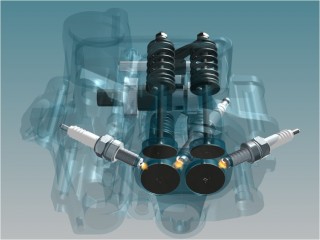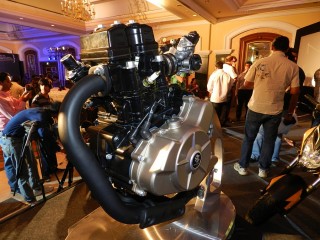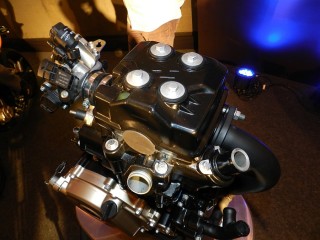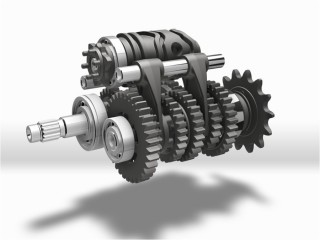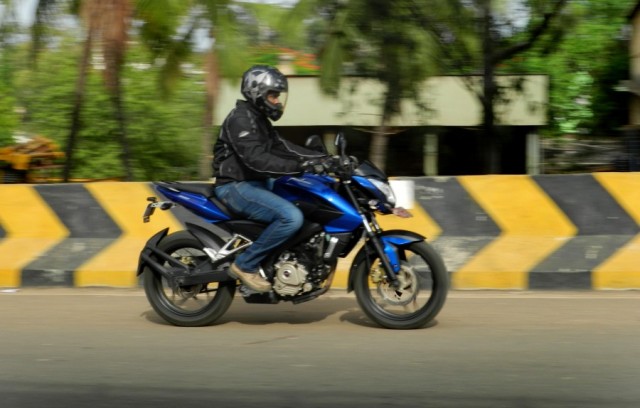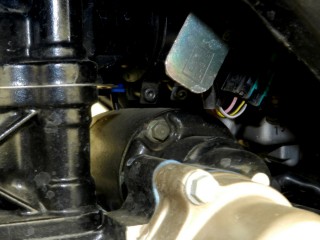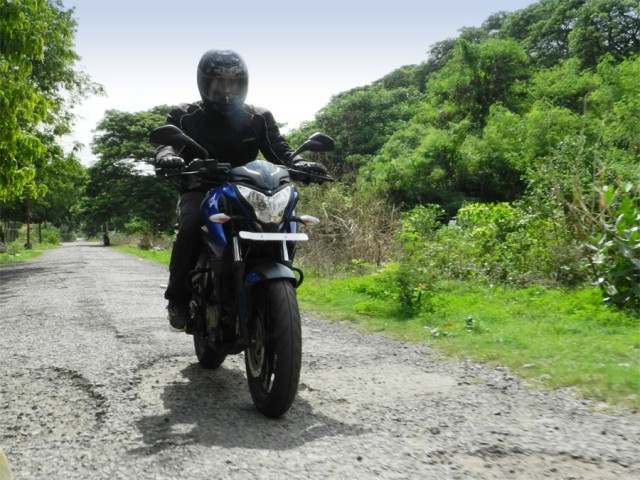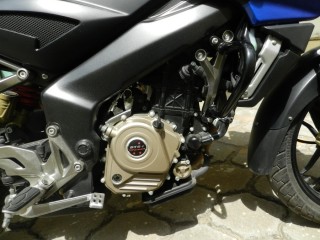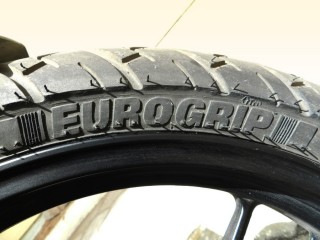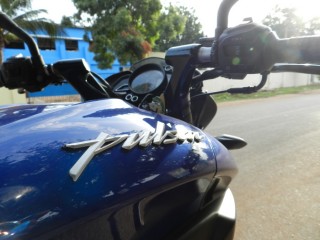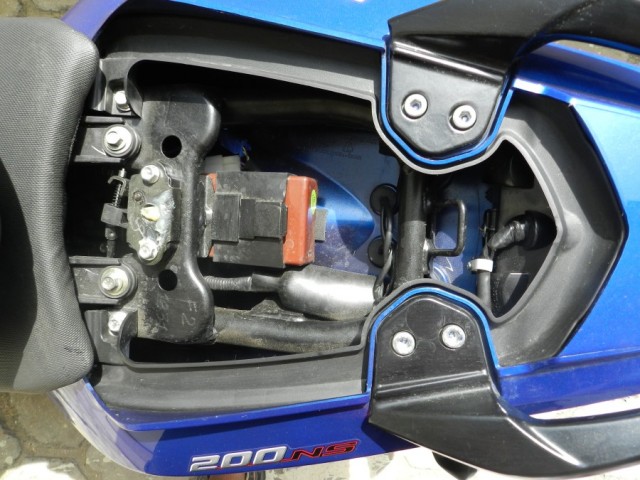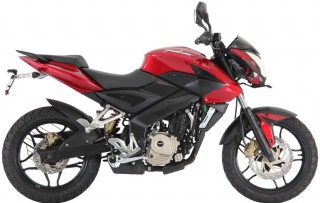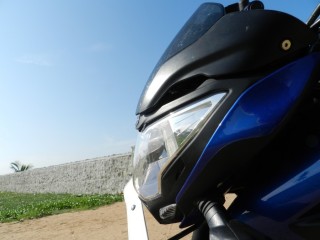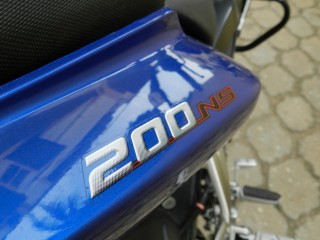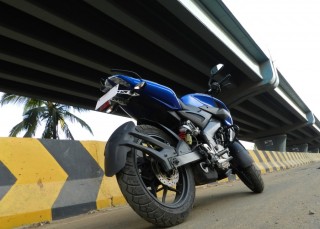When you finally get off the motorcycle, you feel this intense buzz inside that makes you wonder if this is adrenaline and if so much of it is good for you. You also realize that you’ve been riding faster than you normally would and that you’ve been working the gears hard. That isn’t to say that the 200 NS cannot trundle along at sedate speeds in a not so optimum higher gear, it’s just that it would be a waste of potential. The 200 NS’ triple spark, 4 valve single cylinder water cooled engine is the most fantastic piece of machinery to wear the Bajaj badge that calls for an extra pair of eyes, one for the road and the other to feast on how quickly the needle shoots across the little white bars on the tachometer dial.
It shouldn’t have been a surprise. A new power plant in a new chassis and what less can one expect? Blistering performance coupled with the kind of maturity I simply cannot come to terms with. It wasn’t so long ago we had the brute of a Pulsar 220 DTs-Fi on the market and a number of things have happened since then and bang – we have a fresh-as-the-first-light-after-a-rainy-night motorcycle that has been engineered ground up.
Triple Spark
The ‘flame front’, which is the leading edge of the flame that starts from the spark plug and propagates through the air-fuel mixture, has to reach the entire volume of the cylinder to ensure complete combustion, in the short span of time reserved for combustion in the cylinder. To put things in perspective, at 2500 rpm the piston takes around 1/80th of a second to execute the power stroke and at 6000rpm its takes less than 1/200th of a second!
Manufacturers have employed various methods to ensure this happens. The first step would be to use a four valve setup which allows the spark plug to be positioned bang in the centre allowing for a symmetric flame front path that has to travel equal distance in any direction. ‘Swirl’ing the mixture as its enters the cylinder through the inlet is one of the other methods to improve the combustion at the cost of turbulence. ‘Squishing’ the mixture towards the centre, nearer the spark plug, is another method to ensure complete combustion.
Alfa Romeo, one of the pioneers of twin spark plug setup, preferred using the twin plug setup over the much more expensive four valve design in their cars like the Alfa Romeo 75, 155 and 164 in the late ’80s. More recently the Honda Jazz i-DSI used a twin spark setup.
The flame front during combustion of a leaner fuel mixture has a slower propagation rate than a richer mixture. A twin/triple spark overcomes this limitation ensuring better combustion with leaner mixtures leading to better fuel efficiency and cleaner emissions.
Bajaj has used a pent roof design for the cylinder head, which allows for larger valve area. In addition slight squish bands have been designed in to improve combustion. The DTs-i design beats the point of having a pent roof design with four valves, and the choice to have a central plug would have been the most obvious one. The additional slave plugs should give the benefits that DTS-i tech has given Pulsars of the later half of the decade. Triple spark technology should be most effective at part load conditions when it will ensure optimum combustion. Bajaj says combustion in a triple spark engine is 27% faster than a twin spark and 50% faster than a single spark engine.
Was a third spark plug really necessary or could there have been alternate methods, like the multi-spark ignition with one plug per cylinder in the Ferrari F12 berlinetta, is a topic that will always be debated.
Engine & Gearbox
The 200 NS mill is fueled through the 33 venturi UCD33 UCAL carburettor, larger than the carb on the Pulsar 220 DTs-i, the fastest Indian. Of the carburettored motorcycles in the country now, the 200 NS has to be the most delightful to do the blip-downshift routine on. Putting aside the sense of accomplishment every time you pull it off successfully the momentarily orgasmic (we’ll come back to this again) notes from the exhaust when you blip the throttle are reason enough to do it, every single time. This newfound Road Runner-ish ability to rev to the red line really fast had us dredging out the technical specifications of previous Pulsars. While a spec to spec comparo would be largely irrelevant we can tell you this engine is short stroked compared every previous iteration of the Pulsar, including the 135 LS.
Four valves in place of two have the benefit of being physically lighter and smaller. 4 valves also result in a larger valve curtain area resulting in increased flow of air/fuel mixture and improved evacuation of exhaust gases. 4 valves are also what make good high revving power plants.
Engines can be either oversquare, square or undersquare depending on their bore:stroke ratio. The Pulsar 200 NS has a bore: stroke of 1.46 which falls in the oversquare territory. Oversquare engines are said to be far more reliable, more hurried, and good at making power at the higher rpms and not so good with low down torque. There is also the other camp that says while this may have been true before a decade or two, these assumptions are largely irrelevant now thanks to the advancement in engine design.
After time spent with the 200 NS we are not sure where we stand on the undersquare vs oversquare debate. The 200 NS revs lightning quick, makes its peak power of 23.52 PS @ 9500 rpm and maximum torque of 18.3 Nm @ 8000 rpm and also has a healthy mid range. While she could pull comfortably from as low as 28 kph in 6th gear, which assures us of good low end torque, getting her off the line from standstill was not something I could get comfortable with. A fast start is ok; you have your revs pinned at 4k rpm, pop the clutch and off you go. In everyday situations where you have Uncle, Aunty and their kid on the generic beige coloured scooter alongside you at the traffic lights, you really do not want to give them a reason to label all bikers as maniacs. In this scenario, when you feed in the throttle and let out the clutch you cannot help but feel slightly uneasy at least until you hit 3000 odd revs. The NS moves, no doubt about that but it doesn’t do it with confidence. While I’ve been trying to put this in words over the last three days, I stumbled upon Chris Harris’ Living With the McLaren MP4-12C video where he has the perfect analogy. ‘It kind of creeps like a teenage boy outside a girls dormitory…’. Past the four thousand rpm mark, I have to admit I lost all hope in mankind, realized people will judge me anyway, and wrung the throttle to the stop. Uncle and Aunty might have labelled me a maniac, but the kid surely must have had a smile plastered on his face! Scouts ‘Good Deed for the day’ complete!
When the Pulsar 200 NS gets going, it gets going. The revs climb quickly and the limiter doesn’t kick in until 11,000 rpm and that’s more than what the distant cousin KTM Duke 200 can do! There is no discernible mechanical difference from when the crankshaft is spinning at 4k rpm or at 11k rpm. The vibration, if you notice any, remains consistent through out, but the noise from the exhaust rises in increments in tandem with the rise in the revs.
Unless you are getting on the 200 NS from a Duke 200 or a wild child two stroke from yesteryear, you’d be shocked at how fast you are astride the NS. The 200 NS can hit 90 in the blink of an eye and is only a little slower hitting the 110, 120 kph mark. I bet you all the crisp notes in my wallet that your guess-timate of how fast you can hit 80 on the 200 NS would be completely off the mark. She’s just that quick. It doesn’t help that there’s no drama characteristic of all Pulsars getting to the ton. If the 220 DTs-Fi was Hulk, the 200 NS would be a stealthy, efficient, scarily quick Ninja, only clad in leather!
Now back to the bit where I said momentarily orgasmic notes, well, the 200 NS cannot hold a candle to the 220s and the last gen 200 in the aural stimulation department. As Shumi once pointed out, any bike sounds good when you blip the throttle when downshifting, and the 200 NS lives up to the statement. The rest of the time though, the Ninja like stealth and speed is what will grab the edges of your lips and drag them all the way to your ears, not the exhaust note.
You will have trouble finding the choke unless you know what you are looking for. The choke is a metal plate on the left side of the motorcycle, in place of the usual pull-push knob we seen on previous Pulsars. On the 200 NS you pull the choke, and then tap it back into place.
We weren’t paying any attention to the gearbox until a friend popped the question of whether good as that on his FZ. I realized that the NS gearbox is so good at what it does, that I had been completely oblivious to its presence. If you’ve owned a Pulsar you know the gearshift becomes noticeably rougher with each passing hour, when you ride nonstop. Riders have bypassed this problem experimenting with different engine oils. Some found the sweet spot with the Motul 5100T some with the Motul 300V and some seem to be having just enough fun with the Castrol (before Bajaj brought out its Bajaj DTS-i 10000) from the barrell at Probiking.
The 200 NS we believe will have no such issues. The gearbox is slick, finding neutral is easy and we did not experience any false neutrals during our week long stint with the NS. Clutchless up-shifting is a breeze, the cogs fall in line like hot knife through butter, pardon us for the cliche. Downshifting is smooth, but you might have issues letting out the clutch smoothly. Downshifting on the NS works best when you blip the throttle, and slot the lower cog, a technique we sincerely suggest you work on.
Ride & Handling
The steel perimeter frame on the Pulsar 200 NS has thrice the lateral stiffness than the double down tube on the Pulsar 220, and the rectangular section swingarm has a lateral stiffness that is 50% more than that of the 220.
Ride quality on the Pulsars has never been anything less than fantastic, and the 200 NS is no exception. The 200 NS flies through pot holes with abandon. The 220 and the 200 though had marginally better ride quality a price we pay for the fantastic handling on the 200 NS. I strongly believe we would have been waxing eloquent if we had taken the 200 NS to the track, something we intend to do soon.
The Pulsar 200 NS’ suspension is firmer than all previous gen Pulsars put together. The NS is easy to tip into corners, planted enough to inspire confidence in the rider and undeniably, looks good while taking those corners. Anybody who has ridden previous Pulsars will tell you the family’s strength is straight line stability and the weakness, the bull headed stubbornness to change direction. The 200 NS will change all that. The 200 NS is quite flickable and changes direction as any modern day motorcycle should. Unfortunately, what’s also changed is the straight line stability. The 200 NS is as good as its peers on the market today at holding the straight line, but when you compare it to its older siblings, you wonder if it’s just as good.
You would think the new found agility and lackluster straight line stability would be courtesy of the shortened wheelbase, as we have seen astride the Apache RTRs. Surprisingly, no. The 200 NS has a wheelbase longer than the 220 by 13mm and stands at 1363mm! The engineers at Bajaj have mastered the black magic of chassis design and have played with the rake and trail to achieve the balance.
Having sworn loyalty to the fantastic soft rubber on the recent MRF Nylogrips, we found it hard to be convinced by the capability of the Eurogrips shod on the 200 NS. A vast majority of riders should be comfortable with the Eurogrips, noticing no discernible requirement for better rubber. The enthusiasts who feel the need for something better will swap their tyres once they have stripped the current rubber of its chicken strips and treads.
The Perimeter Frame
The perimeter frame, better known to us the twin spar frame is a huge leap for Bajaj from the double cradle downtubes the company has used for years now. We thought a little history, and tech talk were in order.
The twin spar, believe it or not, was born out of the need to accommodate larger engines when the common steel backbone frames required too many adds-ons to hold the engine. Antonio Cobas is considered to be the father of current day twin spar frames when he built the first twin beam aluminium frame housing a 250 Rotax engine for the Grand Prix.
Not unlike you, we were also wondering if Bajaj could have taken things a notch further and used aluminium in place of steel for the frame. While the weight savings would have been substantial, it would have driven the costs up. Steel has a higher fatigue strength than aluminium, meaning longer life. In addition aluminium does not have a ‘true endurance limit‘ meaning, regardless of the amplitude of stress, if aluminium is subject to enough stress cycles, it will suffer fatigue failure. Engineers have to take this into account and design the frame to ensure it has a substantial life span. All this would drive the expenses in only one direction-up.
The Yamaha R15 uses a steel deltabox, while the bigger siblings use aluminium.
Ergonomics
The saddle height on the 200 NS is slightly higher but not so much as to be uncomfortable for most riders. The saddle height is perfect when you’re on the move giving you a fantastic perch on the 200 NS. The mirrors provide optimum views unlike the 220, but the we noticed a slight distortion at the edges of the mirror which was disconcerting on the move. Cost cutting?
Cold air from the front passes through the radiator, over the jacketed cylinder and the now considerably warm air flows out through the functional air vents on the side panel which are positioned just slightly below your thighs. Not an issue you will notice most of the time, but caught in really bad traffic jams, you might just decide it to be the most opportune moment to thank your denims.
The handlebars are a joy to hold on to. The feeling is most intense when you countersteer the NS into a corner, it feels just right. The handlebars are still clip ons, but are designed to be idiot proof and will not have amateurs throwing their body weight on their wrists. The grips of the handlebar are of optimum length, with not too long bar end weights, and are also soft enough that you won’t have callused skin on your thumb, if you ride without gloves.
The pass switch is a bit of a reach when you have your thumb on the horn, which is most of the time, at least in the city. The indicator is of the push to cancel type, and could have been slightly larger. The switch is perfect when you ride without gloves, but put your gloves on and you do not get enough feedback and you have to look down at the console to see if the indicators have been activated. We also did not like the fact that Bajaj’s ‘current’ flagship did not come with self cancelling indicators, a luxury cannot live without once you get used to it.
The Mode and Set buttons on the console are also slightly hard to operate requiring a bit too much pressure.
The side stand is of the most perfect dimensions you can imagine and putting it down while still in the saddle is something you’ll do with style. You do not get the main stand as standard, it is an optional extra.
Instrument Console
The Pulsar gets a clock in the instrument console, finally. The console is a simple, stylish affair with just the most essential info on display.
The newer addition is also the service reminder icon that pops up at 450km for the first service and subsequently for every additional 5000 kms. The service reminder icon can be reset by the rider too.
The Coolant Temperature Indicator blinks when the coolant temperature rises above 115 °C something that never happened when we were crawling through traffic. The Low Oil Pressure indicator of course, blinks when you need to top up the engine oil.
There’s also the new Side Stand indicator which won’t stop you from cranking the engine, but will glow in danger red to indicate that the side stand needs to be put up.
A gimmicky Bajaj logo glows Blue all the time, our only ( yes, only) complaint being it should have been a lighter shade to reflect the actual Bajaj blue.
The chrome ringed orange light at the top is dual functional as with previous Pulsars. It glows when you are whipping the engine beyond the 10,000 rpm or when your fuel level drops to reserve. Of the 12L tank capacity, reserve on the Pulsar 200 NS is about 2.4L of which 0.2L is not usable, preventing air lock we believe.
Electricals
At the unveiling of the 200 NS in Mumbai, Bajaj suggested the headlamps would be 35W, surprisingly though, by the time the NS was rolling off the assembly line, the headlamps were swapped for 55W units. Full DC electricals mean the illumination is constant regardless of the throttle position. The beam spreads out and the intensity is uniform. The high beam is fairly functional.
The Pulsar 200 NS uses a totally sealed VLRA (Valve Regulated Lead Acid) battery which is compact compared to conventional lead acid batteries. The VLRA unit does not require top ups, there is no chance of electrolyte spillage and more importantly it can be mounted at any angle. Bajaj in its quest for the most compact package decided to use the space underseat and the mounting surface is slightly inclined, and a conventional battery would have posed the risk of spillage if mounted on such surface.
The miserable single horn makes you want to push the bike into a pond and wait for the electricals to die and the horn to croak to death. The pitiful horn goes ‘beep’ and people do not grasp the reality of the situation that it is this screaming monster clothed in Blue that just rolled up behind them that’s making the noise. A better twin horn setup as an optional extra at least, Bajaj?
For those of you who have been worried about the low slung exhaust and its effectiveness after a wade through the flooded roads of our metros during the monsoons, here’s some assurance.
Colors Available
In addition to the Blue we tested the 200 NS also comes in Yellow, Black and Red. You might want to drop by the Bajaj showroom before selecting your colour as the Black and Yellow have a slightly different finish.
Design
Hard to believe that the signature Pulsar tank has been around for ten years now. Designers at Bajaj were given a clean slate this time, without having to work their design around the signature tank. The actual tank is now hidden underneath the layers of plastic panels. The plastic surface around the tank should put off riders who prefer magnetic tank bags but shouldn’t be a deterrent considering you have suction based bags available.
The forward crouched stance is accentuated by the tight packaging of the engine in the perimeter frame. The Pulsar 200 NS is not unlike a crouching predator with all the muscles tense, in a feral display of the potential for strength, or in our case, performance.
The pilot lamps, which are now a signature design characteristic for Pulsars have been shrunk, narrowed, and positioned just beneath the actual headlamp. The headlamp is a strong design element that distinguishes this Pulsar from the previous generations, yet bears resemblance to a number of other bigger naked bikes.
Verdict
There hasn’t been a motorcycle in the country that has had to carry unwanted baggage like the Pulsar has had to. Ask any misinformed motorcyclist to review any Pulsar and he will put down the negatives as ‘handling’ and ‘reliability’ regardless of whether he is penning the review before or after riding the bike. While it is fair to say that the Pulsars of yesterday lack the endurance and the handling required to put in lap after lap consistently at the race track, it is ridiculous to say the handling wasn’t good enough for the street or the highway. Legions of Pulsar Maniacs who have delighted us with their weekend stints at Lavasa should stand testament to this.
The new Pulsar 200 NS is the addition to Bajaj’s arsenal that will set the record straight in the handling department. The 200 NS beneath all the extremely styled complex surfaces and lines is a very mature motorcycle engineered to be fantastic, regardless of what you throw at it.
Is the 200 NS worth the sticker price? We think so. A shared bottom end with the KTM Duke 200, better fuel efficiency than the Duke 200, build, fit and finish like we’ve never seen on a Pulsar before and fantastic all round capability characteristic of Pulsars, make the 200 NS a worthy expenditure.
I do feel a pang of sadness though, when I realize that future generations of Pulsar owners will no longer do the chicken dance, or conduct week long seminars on engine oil grades and JASO rating. They will not have the need to find innovative ways to put to use double sided tape or delve into the depths of the mechanics of brake calipers and disc pads. When you ride a Pulsar you do manly stuff like standing up for your Pulsar when she’s just seconds slower than a lower displacement Apache RTR or decades old Karizma on the track, a privilege that shall be denied to Pulsar 200 NS owners. The new Pulsar 200 NS is just that good.
Review by : Pradeep Mohan



